The AMD 2nd Gen Ryzen Deep Dive: The 2700X, 2700, 2600X, and 2600 Tested
by Ian Cutress on April 19, 2018 9:00 AM ESTCPU Legacy Tests
Our legacy tests represent benchmarks that were once at the height of their time. Some of these are industry standard synthetics, and we have data going back over 10 years. All of the data here has been rerun on Windows 10, and we plan to go back several generations of components to see how performance has evolved.
All of our benchmark results can also be found in our benchmark engine, Bench.
3D Particle Movement v1
3DPM is a self-penned benchmark, taking basic 3D movement algorithms used in Brownian Motion simulations and testing them for speed. High floating point performance, MHz and IPC wins in the single thread version, whereas the multithread version has to handle the threads and loves more cores. This is the original version, written in the style of a typical non-computer science student coding up an algorithm for their theoretical problem, and comes without any non-obvious optimizations not already performed by the compiler, such as false sharing.
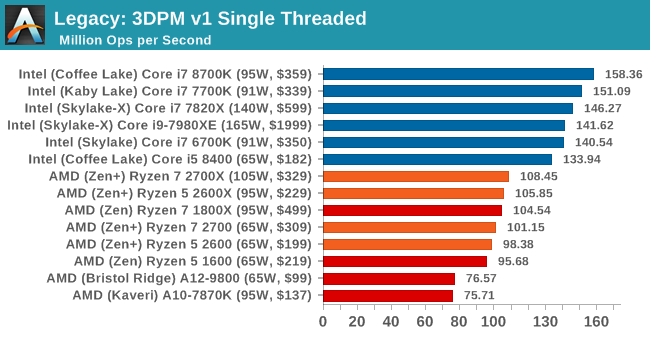
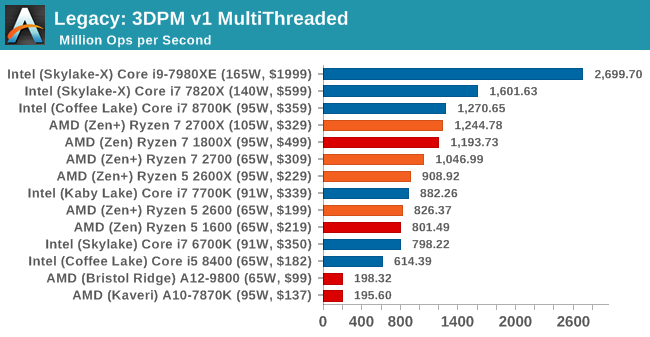
CineBench 11.5 and 10
Cinebench is a widely known benchmarking tool for measuring performance relative to MAXON's animation software Cinema 4D. Cinebench has been optimized over a decade and focuses on purely CPU horsepower, meaning if there is a discrepancy in pure throughput characteristics, Cinebench is likely to show that discrepancy. Arguably other software doesn't make use of all the tools available, so the real world relevance might purely be academic, but given our large database of data for Cinebench it seems difficult to ignore a small five minute test. We run the modern version 15 in this test, as well as the older 11.5 and 10 due to our back data.
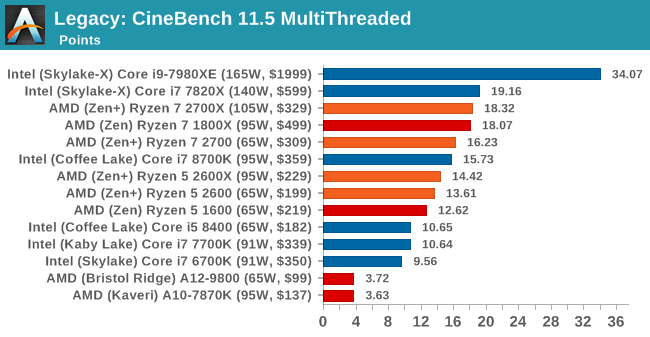

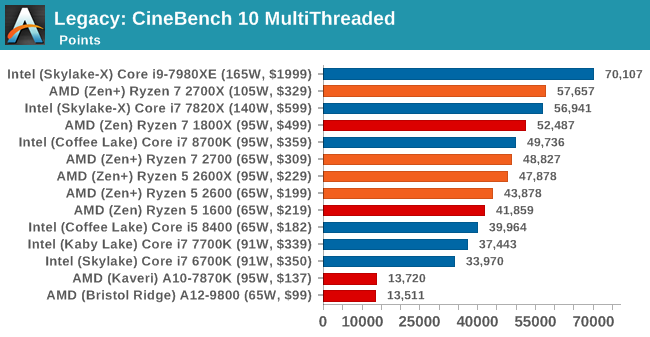
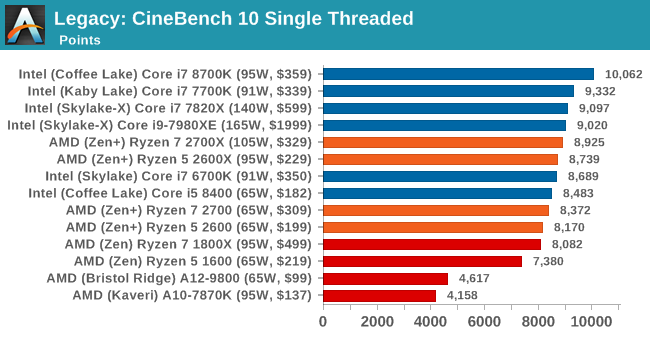
x264 HD 3.0
Similarly, the x264 HD 3.0 package we use here is also kept for historic regressional data. The latest version is 5.0.1, and encodes a 1080p video clip into a high quality x264 file. Version 3.0 only performs the same test on a 720p file, and in most circumstances the software performance hits its limit on high end processors, but still works well for mainstream and low-end. Also, this version only takes a few minutes, whereas the latest can take over 90 minutes to run.
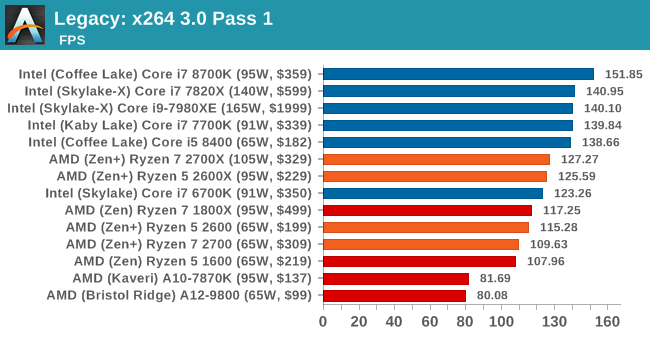
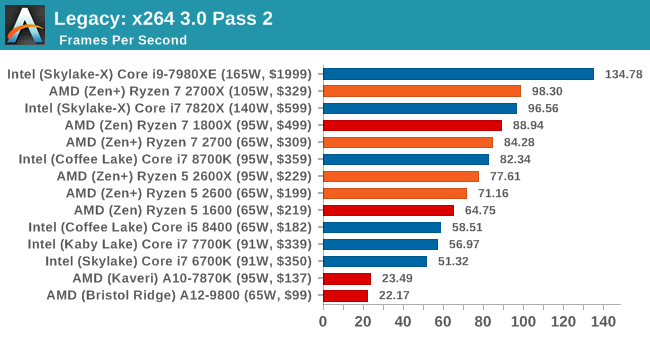










545 Comments
View All Comments
YukaKun - Saturday, April 21, 2018 - link
Oh, I'm actually curious about your experience with all the systems.I'm still running my i7 2700K at ~4.6Ghz. I do agree I haven't felt that it's a ~2012 CPU and it does everything pretty damn well still, but I'd like to know if you have noticed a difference between the new AMD and your Sandy Bridge. Same for when you assemble the 2700X.
I'm trying to find an excuse to get the 2700X, but I just can't find one, haha.
Cheers!
Luckz - Monday, April 23, 2018 - link
The the once in a lifetime chance to largely keep your CPU name (2700K => 2700X) should be all the excuse you need.YukaKun - Monday, April 23, 2018 - link
That is so incredibly superficial and dumb... I love it!Cheers!
mapesdhs - Monday, April 23, 2018 - link
YukaKun, your 2700K is only at 4.6? Deary me, should be 5.0 and proud, doable with just a basic TRUE and one fan. 8) For reference btw, a 2700K at 5GHz gives the same threaded performance as a 6700K at stock.And I made a typo in my earlier reply, mentioned the wrong XEON model, should have been the 2680 V2.
YukaKun - Tuesday, April 24, 2018 - link
For daily usage and stability, I found that 4.6Ghz worked best in terms of noise/heat/power ratios.I also did not disable any power saving features, so it does not work unnecessarily when not under heavy load.
I'm using AS5 with a TT Frio (the original one) on top, so it's whisper quiet at 4.6Ghz and I like it like that. When I made it work at 5Ghz, I found I had to have the fans near 100%, so it wasn't something I'd like, TBH.
But, all of this to say: yes, I've done it, but settled with 4.6Ghz.
Cheers!
mapesdhs - Friday, March 29, 2019 - link
(an old thread, but in case someone comes across it...)I use dynamic vcore so I still get the clock/voltage drops when idle. I'm using a Corsair H80 with 2x NDS 120mm PWM, so also quiet even at full load; no need for such OTT cooling to handle the load heat, but using an H80 means one can have low noise aswell. An ironic advantage of the lower thermal density of the older process sizes. Modern CPUs with the same TDP dump it out in a smaller area, making it more difficult to keep cool.
Having said that, I've been recently pondering an upgrade to have much better general idle power draw and a decent bump for threaded performance. Considering a Ryzem 5 2600 or 7 2700, but might wait for Zen2, not sure yet.
moozooh - Sunday, April 22, 2018 - link
No, it might have to do with the fact that the 8350K has 1.5x the cache size and beastly per-thread performance that is also sustained at all times—so it doesn't have to switch from a lower-powered state (which the older CPUs were slower at), nor does it taper off as other cores get loaded, which is most noticeable on the the things Samus mentioned, ie. "boot times, app launches and gaming". Boot times and app launches are both essentially single-thread tasks with no prior context, and gaming is where a CPU upgrade like that will improve worst-case scenarios by at least an order of magnitude, which is really what's most noticeable.For instance, if your monitor is 60Hz and your average framerate is 70, you won't notice the difference between 60 and 70—you will only notice the time spent under 60. Even a mildly overclocked 8350K is still the one of best gaming CPUs for this reason, easily rivaling or outperforming previous-gen Ryzens in most cases and often being on par with the much more expensive 8700K where thread count isn't as important as per-thread performance for responsiveness and eliminating stutters. When pushed to or above 5 GHz, I'm reasonably certain it will still give many of the newer, more expensive chips, a run for their money.
spdragoo - Friday, April 20, 2018 - link
Memory prices? Memory prices are still pretty much the way they've always been:-- faster memory costs (a little) more than slower memory
-- larger memory sticks/kits cost (a little) more than smaller sticks/kits
-- last-gen RAM (DDR3) is (very slightly) cheaper than current-gen RAM (DDR4)
I suppose you can wait 5 billion years for the Sun to fade out, at which point all RAM (or whatever has replaced it by then) will have the same cost ($0...since no one will be around to buy or sell it)...but I don't think you need to worry about that.
Ferrari_Freak - Friday, April 20, 2018 - link
You didn't write anything about price there... All you've said is that relative pricing for things is the same it has always been, and that's no surprise.The $$$ cost of any give stick is more than it was a year or two ago. 2x8gb DDR4-3200 G.Skill Ripjaws V is $180 on Newegg today. It was $80 two years ago. Clearly not the way they've always been...
James5mith - Friday, April 20, 2018 - link
2x16GB Crucial DDR4-2400 SO-DIMM kit.https://www.amazon.com/gp/product/B019FRCV9G/
November 29th 2016 (when I purchased): $172
Current Amazon price for exact same kit: $329